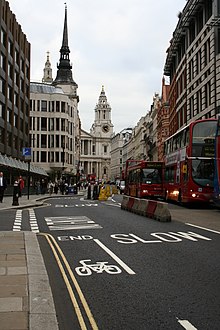Ludgate Hill
This article needs additional citations for verification. (October 2010) |



Ludgate Hill is a street and surrounding area, on a small hill in the City of London, England. The street passes through the former site of Ludgate, a city gate that was demolished – along with a gaol attached to it – in 1760.
The area includes
Ludgate Hill itself is traditionally regarded as one of a trio of hills in Central London, the others being
The modern street named Ludgate Hill, which was previously a much narrower thoroughfare named Ludgate Street, runs between St Paul's Churchyard and Ludgate Circus (built in 1864), at which point it becomes Fleet Street.
Description
Many small alleys on Ludgate Hill were swept away in the mid 1860s to build Ludgate Hill railway station between Water Lane and New Bridge Street, a station of the London, Chatham and Dover Railway. It was closed to passengers in 1929 and the railway bridge and viaduct between Holborn Viaduct and Blackfriars stations was demolished in 1990 to enable the construction of the City Thameslink railway station in a tunnel. This also involved the regrading of the slope of Ludgate Hill at the junction.
There is a
About halfway up Ludgate Hill is the church of St Martin, Ludgate, once physically joined to the Ludgate.
Paternoster Square, home of the London Stock Exchange since 2004, is on the hill, immediately to the north of St Paul's Cathedral.
Etymology
Ludgate is generally accepted to derive from the Old English term "hlid-geat"[2][3][4][5][6] from "hlid" ("lid, cover, opening, gate")[7] and "geat" or "gæt" ("gate,[2] opening, passage")[8] and was a common Old English compound meaning "postern" or "swing gate"[2][3][4][6] and survives in various place names across England[4] as well as in surnames.[9]
Ludgate is mentioned in
Literary associations
At the bottom of Ludgate Hill, on the north side, is Limeburner Lane. This may sound like a quaint survival from medieval times, but it was actually constructed in the 1990s, where Seacoal Lane used to be. This was the location of the
The prison is mentioned in Daniel Defoe's Roxana: The Fortunate Mistress.
From 1731, the "London Coffee House" was next to St Martin's, Ludgate, at 24–26 Ludgate Hill. It was frequented by Joseph Priestley and Benjamin Franklin. When the juries at the Old Bailey failed to reach a verdict, they were housed here overnight. In 1806, a Roman hexagonal altar dedicated to Claudia Martina by her husband, now in the Guildhall, was found here together with a statue of Hercules.[14] The London Coffee House was closed in 1867, and is now occupied by a pub called "Ye Olde London".
Edmund Spenser's The Shepheardes Calender was printed by Hugh Singleton at the sign of the "Gylden tunne" in Creed Lane in 1579. John Evelyn lived in the Hawk and Pheasant on Ludgate Hill in 1658–59.
The
Pageantmaster Court is almost opposite St. Martin's. The name is not medieval but dates from 1993. However, to the west is King's Arms Court, which existed until recently.
William Hone, journalist and publisher had an office near Ludgate Hill and the Old Bailey during the mid 1800s.
Notable residents
- Samuel Birch (military officer)
- William Harvey (1578–1657) – discovered the circulation of the blood, 1628. From 1604–1639 Harvey held a residence in the precincts of St Martin's Church, Ludgate.
References
- ^ Ordnance Survey data
- ^ ISBN 0-19-726221-X, 9780197262214, pp.623–266
- ^ a b Geographical Etymology, Christina Blackie, pp.88
- ^ a b c English Place-Name society, Volume 36, The University Press, 1962, pp.205
- ISBN 0-472-01124-3pp. 972
- ^ a b An encyclopaedia of London, William Kent, Dent, 1951, pp.402
- ^ "Lid | Origin and meaning of lid by Online Etymology Dictionary".
- ^ "Gate | Origin and meaning of gate by Online Etymology Dictionary".
- ^ "Surname Database: Ludgate Last Name Origin".
- ISBN 978-0-85991-641-7.
- ^ "...the Historia does not bear scrutiny as an authentic history and no scholar today would regard it as such.": Wright (1984: xxviii)
- ^ Ackroyd, Peter (2 December 2001). "London". New York Times. Archived from the original on 15 April 2009. Retrieved 28 October 2008.
- ^ The London Gazette of 10 October 1684
- ^ Ref 1 below
- Brewer, Ebenezer Cobham. Dictionary of Phrase and Fable. London: Cassell and Company, 1905. Page 780.
